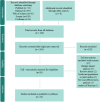Economic evaluation of adding dapagliflozin to standard care in the treatment of chronic kidney disease: a systematic review
- PMID: 39695416
- PMCID: PMC11657770
- DOI: 10.1186/s12882-024-03901-7
Economic evaluation of adding dapagliflozin to standard care in the treatment of chronic kidney disease: a systematic review
Abstract
Introduction: Chronic kidney disease is a significant public health issue. Dapagliflozin has been shown to improve the quality of life for patients with chronic kidney disease. This review aimed to systematically assess the cost-effectiveness of adding dapagliflozin to standard care compared with standard care alone for treating chronic kidney disease.
Methods: The relevant studies were searched in PubMed, Web of Science, Scopus, Embase, and Cochrane from the inception date to June 1, 2024. The titles, abstracts, and full texts were independently evaluated and screened by two authors. Additionally, the economic evaluation studies were assessed independently by two authors using the consolidated health economic evaluation reporting standards checklist.
Results: 14 studies were included which were about the economic evaluations of adding dapagliflozin in the treatment of chronic kidney disease. The minimum consolidated health economic evaluation reporting standards score for the studies was 0.77, indicating very good quality. Adding dapagliflozin to the standard of care would be more effective and cost-saving in Mexico, Malaysia, Canada, Thailand, and China. The highest incremental cost-effectiveness ratio of dapagliflozin ($67962.75/QALY) originated from the USA. According to the available studies, adding dapagliflozin to standard of care for the treatment of chronic kidney disease is considered cost-effectiveness from both the healthcare system and the payer's perspective.
Conclusion: Adding dapagliflozin to standard care in the treatment of chronic kidney disease is cost-effective from both the healthcare system and the payer's perspective in well-developed countries.
Keywords: Chronic kidney disease; Dapagliflozin; Economic evaluations; Standard care; Systematic review.
© 2024. The Author(s).
Conflict of interest statement
Declarations. Ethics approval and consent to participate: Not applicable. Consent for publication: Not applicable. Competing interests: The authors declare no competing interests. Clinical trial number: Not applicable. Human participant protection: This systematic review was limited to published research and did not involve human participants, and as such, human participant protection was not required.
Figures
Similar articles
-
A cost-utility analysis of adding SGLT2 inhibitors for the management of type 2 diabetes with chronic kidney disease in Thailand.Sci Rep. 2025 Jan 2;15(1):249. doi: 10.1038/s41598-024-81747-7. Sci Rep. 2025. PMID: 39747138 Free PMC article.
-
Cost-effectiveness evaluation of add-on dapagliflozin for heart failure with reduced ejection fraction from perspective of healthcare systems in Asia-Pacific region.Cardiovasc Diabetol. 2021 Oct 9;20(1):204. doi: 10.1186/s12933-021-01387-3. Cardiovasc Diabetol. 2021. PMID: 34627231 Free PMC article.
-
Cost-utility analysis of empagliflozin on chronic kidney disease progression in Thailand.J Med Econ. 2025 Dec;28(1):387-397. doi: 10.1080/13696998.2025.2474887. Epub 2025 Mar 13. J Med Econ. 2025. PMID: 40035266
-
Translating the efficacy of dapagliflozin in chronic kidney disease to lower healthcare resource utilization and costs: a medical care cost offset analysis.J Med Econ. 2023 Jan-Dec;26(1):1407-1416. doi: 10.1080/13696998.2023.2264715. Epub 2023 Oct 31. J Med Econ. 2023. PMID: 37807895 Review.
-
Cost Effectiveness of Adding Dapagliflozin to Standard Care in Heart Failure Patients with Reduced Ejection Fraction: A Systematic Review.Am J Cardiovasc Drugs. 2023 Mar;23(2):127-144. doi: 10.1007/s40256-022-00564-3. Epub 2023 Feb 1. Am J Cardiovasc Drugs. 2023. PMID: 36725789
References
-
- Nava-Vargas MG, Arellano-Arteaga KJ, Cortés-Sanabria L, et al. Wcn23-1211 cost-effectiveness analysis of Dapagliflozin for Diabetic kidney disease in Mexico. Kidney Int Rep. 2023;8(3). 10.1016/j.ekir.2023.02.459.
-
- Bello AK, Okpechi IG, Levin A, et al. An update on the global disparities in kidney disease burden and care across world countries and regions. Lancet Glob Health. 2024;12(3):e382–95. 10.1016/S2214-109X(23)00570-3. - PubMed
Publication types
MeSH terms
Substances
LinkOut - more resources
Full Text Sources
Medical




